| Home -> Other California History Books -> San Diego - Panama California Exposition - Text | |||
 |
|||
 |
|||
| Climate As a general proposition the climates of California are good; some are better than others, and San Diego's is the best. A climate, to be good, must be neither too hot nor too cold; there must be no extremes of temperature, no violent changes or atmospheric disturbances, such as electrical, rain or wind storms, resulting in the loss of property and human life. Such a climate as this approaches the ideal as far as man's knowledge goes. San Diego has such a climate: it is almost an ideal climate. It is the best climate in California, and this is saying a good deal in its favor. It is the best in the United States, which is covering more territory, but perhaps adding very little to the recommendation; it may have its equal in the world, but no superior. Temperatures of 90 degrees or over occur on an average less than twice a year. Average summer temperature, 68; winter, 60. Normal rainfall is 10.00 inches, and thunder storms are of extremely rare occurrence. Nature has smiled in its kindliest mood upon this favored spot, and bestowed upon it these almost perfect climatic conditions that make for the comfort, zest and joy of life obtainable nowhere else. Tourists History and romance vie with each other in winning the hearts of the visitors, for San Diego stands as the beginning in California. History will tell you that here was planted the first wooden cross, followed by the first church, followed in turn by the first town. The Mission Fathers soon commenced the cultivation of the soil, producing the first palms, the first vine and the first olive tree. Here they established, likewise, the first irrigation system; the original dam is still standing. A traveler may walk about the spot where was raised the first flag; may wander amid the ruins of old adobe buildings; may ring the old Mission Bells, which were brought from Spain; may sit in the old enclosure of Ramona's Marriage Place, and dream of other Alessandros, and other Ramonas whose pictures, perhaps, they may have seen in the Wishing Well. Here are to be found, too, fruits and flowers of the semi-tropical zone - orange, lemon and olive orchards, and extensive vineyards; the poinsettia, the bougainvillea and other brilliant exotics. |
|||
 |
|||
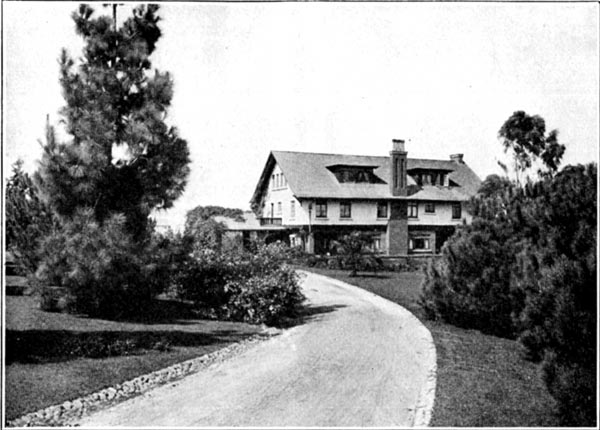 |
|||
| A City of Homes For those desiring a climate where living can be enjoyed every day of the year to the fullest extent, with the addition of good educational facilities, and the highest products and most modern comforts of civilization, San Diego presents, in its rapidly growing city, the ideal location for which they are inquiring. Next to climate, good roads is the greatest asset of San Diego County. Approximately $2,000,000.00 have been expended recently in the construction of between five and six hundred miles of wonderful contour roadways. These drives lead through mountains, the beauties of which are comparable only to those of Yosemite Valley, with forests of oak and pine, with running streams the year around and with landscape effects that will ever delight the eye of the beholder. The state highway, now nearly completed, traverses the county from its northern boundary to the Imperial County line, affording easy access to the famous and fertile Imperial Valley. The Sportsman's Paradise All sports can be enjoyed Every Day In the Year something impossible at any other place on the Pacific or Atlantic Coasts. Yachting Swimming Tennis Football Motorboating Polo Baseball Automobiling Rowing Golf Deep-Sea and Surf Fishing San Diego possesses one of the finest theatres in the West, costing $1,000,000.00; an up-todate open-air amusement park; a large and attractive tent city; children's open-air play grounds; about two thousand acres of public parks; numerous interesting beach and mountain resorts. The beaches are, perhaps, the greatest of the many attractions of this alluring spot, and are an ever-inviting source of health and pleasure. The ocean waters lapping the shores of San Diego are the warmest to be found on the Pacific Coast. $150,000.00 stadium, seating twenty-two thousand, now in course of construction. |
|||
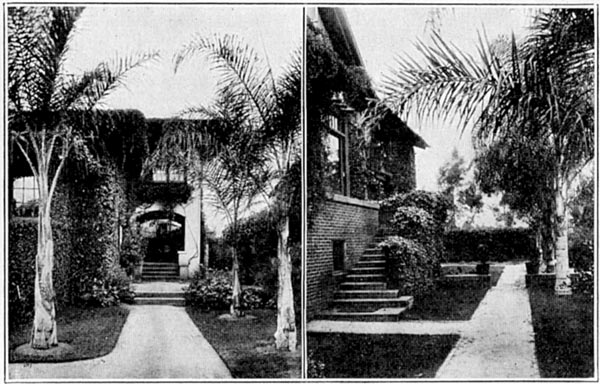 |
|||
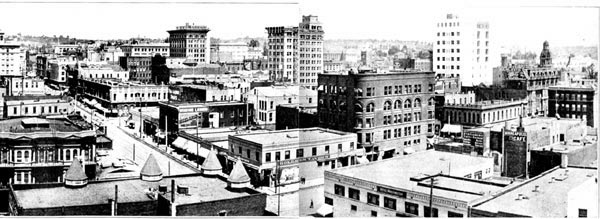  |
|||
 |
|||
| San Diego Has: Ninety thousand population. Unexcelled educational facilities. Perpetual sunshine. Water system owned by city. A harbor equal to New York. Finest salt water fishing. Fifty-four churches. Seventy miles of street railway. Twelve banks, capital $3,000,000.00; deposits $23,000,000.00. Art League. Floral Association. A commission form of government. Fifteen thousand telephone subscribers. Fresh vegetables and fruits every day in the year. 500,000 acres of unimproved land in the county. Trebled in population in the last five years. Fourth city in population in California. Nine improvement clubs and federation. Thirty-nine state societies and federation. A 10,000,000 gallon per diem water filtration and aerating plant. State Normal School, $200,000.00. Polytechnic School, $200,000.00, capacity 750. High School, $315,000; 40 instructors; over 1,000 attendance. Twenty-two square miles of anchorage ground in harbor. Two hundred manufacturing industries in operation. $500,000.00 improvements by the Santa Fe Railroad. Nearest port of entry for the trade of the Orient. One great transcontinental railroad, another one building and a third in prospect. Harbor deep enough to admit the largest ships afloat. Historically of first interest on Pacific Coast. Largest all-the-year-round resort hotels in the world. More automobiles in proportion to its population than any other city in America. Most direct route from Pacific Coast to the Eastern and Middle Western States. San Diego Has: $150,000 Y. M. C. A. building just completed, which amount was raised in twelve days' canvass. The only deep water port on the west coast from Panama to San Francisco. The future New York of the Pacific Coast, and the most promising field for home building in America. Roads good every day in the year, and all roads lead to the blue waters of the Pacific. Three daily newspapers and several weekly newspapers. First port of call from the Panama Canal. Raised $4,800,000.00 for development purposes in one year. Two thousand acres of park lands now valued at $5,519,000. Purest and cheapest water (mountain) of any city of its size in America. Twenty-three hotels; two of which cost $3,500,000.00. One of the best libraries in the country, a depository for U. S. Government Documents. Twenty-one theatres. The place where thousands of European tourists will land, who now never get west of the Rocky Mountains. Largest and best equipped aviation field and training school for aviators in America. Birdmen in the sky every day in the year. An average wind velocity of five miles an hour in January. Railroad terminal, ocean outlet and nearest banking metropolis of the great Imperial Valley of Southern California, and the wonderful Salt River Valley of Arizona. Distributing point and controlling factor in the development of Lower California. Ninety-seven secret orders and fraternal societies, four of which have expensive club and lodge rooms, viz: Elks, Masons, Knights of Pythias and Eagles. Twenty-four public schools, value $1,559,000.00, and employing 250 teachers. Record for 1912 - Greatest building gain per capita of any city in the world. |
|||
 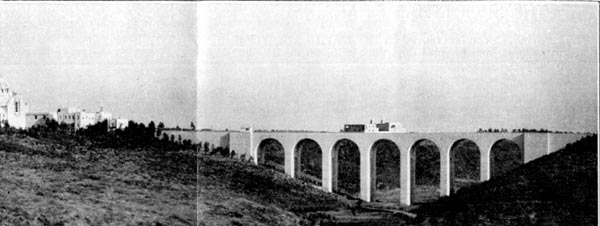 |
|||
|
The San Diego Exposition, Five months before opening, stretch shown, One mile.
|
|||
| The Exposition Beautiful Before the largest audience ever assembled in Southern California this section of the country will present in 1915 the wonders which the climate and the people of the southwest have produced. Differing from the San Francisco world's fair in scope, in purpose and the finest details of treatment, the San Diego Exposition presents glories which could not be shown outside of Southern California. High on a mesa it stands, overlooking canyons, city and sea, looking back over fertile valleys to the Sierras and the low hills of Old Mexico less than twenty miles to the south, looking one way and another to the shining waves over which came the caravels of Spain nearly four centuries ago, and over the land across which trod the soldiers, the adventurers and the priest colonizers who brought civilization to the west coast. The traditions of those days are crystallized in the art and architecture of the Exposition Beautiful, just as the mighty achievements and the mightier possibilities of the great west are crystallized in its agricultural display. It is an Exposition of the opportunities of the west at the same time that it is an Exposition of its beauties, and therein lies its transcendent importance. On that mesa 300 feet above the sea, looking down upon the Harbor of the Sun, stand no buildings of conventional type, but buildings of Spanish design, the design which is woven closely into the romantic traditions of Southern California. And they are filled with no exhibits of conventional style, but exhibits that live and move and breathe a human interest, and they are surrounded with wide lawns and gardens rich with shrubbery, through which filters the soft, steady breeze from the sea which keeps San Diego's winters balmy and her summers cool. Here all the year is June. Here blooms the rose when other lands are chill with snow and ice. Here the air is cool with a zephyr and sweet with the intoxicating fragrance of the orange blossoms when elsewhere man is stifling in the pitiless heat of midsummer. Here rain comes seldom, the valleys of Southern California getting their water mainly from the surrounding hills. In such a climate it was possible to abandon old ideas and present new ones, for men had only to take advantage of what Nature gave in abundance. Thus it was possible to have, instead of the time-worn pyramid of oranges, a great citrus orchard, through which visitors can wander and, reaching upward, touch the citrus blossoms, or see in various stages of development the orange, the lemon, the grapefruit or kumquat or loquat. Across the way is the model intensive farm, marking the top point in agricultural efficiency, a revelation to the east. Up the Alameda is the tea plantation of Sir Thomas Liptonbrought from Ceylon, cultivated by Singalese men and girls, holding promise of a new American industry. A vast amount of the 614 acre space, within the 1400 acre park, is devoted to open air exhibits. These outdoor exhibits are examples of the spirit of the Exposition, the idea of showing, not the products which the visitor could see every day, but the processes in the making of the products - furnishing the visitor with a chance to gratify the altogether human desire to "watch the wheels go 'round." The Japanese booths do not display alone the rare products of Japan, but the artists and artisans doing their exquisite wood and ivory carving, the lacquer work, the weaving, the silk embroidery. Russian peasants will demonstrate the Koustarnyi arts. Italians will labor at the fine arts for which Florence and Venice are famous. Somewhat similar and on a great scale is the work of the "Painted Desert," the most interesting American Indian display that has ever been attempted. A large reserve is cut by a mesa, to the west of which is the exhibit of the Navajos and other wandering tribes with a few of the Cliff Dwellers perched high in the rocky cliff. The Indians are already established there, weaving rugs and blankets and making pottery, bead embroidery and metal ornaments. The Exposition is a massing of the West's resources, not an event concerning San Diego alone. The intent is to encourage visitors to travel through the Northwest and the Southwest alike to see what the individual sections offer, in scenery and in practical opportunity. Through San Diego's exposition speaks the new west, telling the world to come, to see what has been done, to join in what remains to be done. |
|||
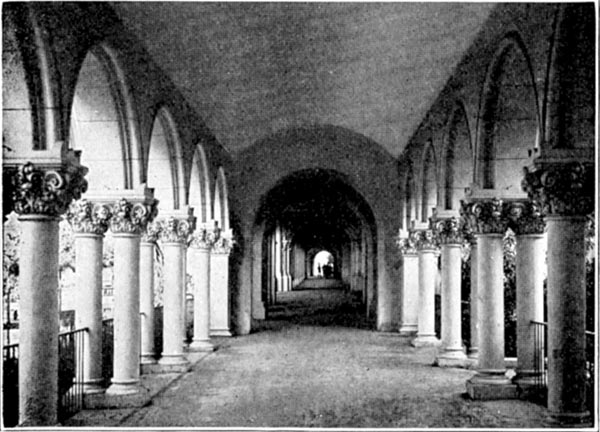 |
|||
 |
|||
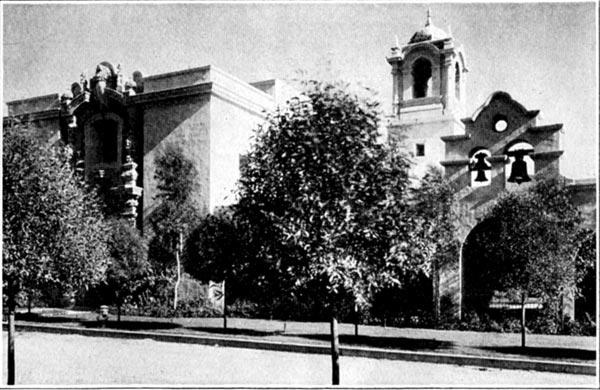 |
|||
 |
|||
 |
|||
|
This folder is published by the Board of Supervisors, San Diego County
|
|||
|
|
|||